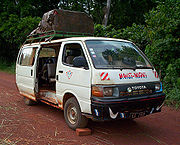Public transport (or public transportation, public transit or mass transit) comprises passenger transportation services which are available for use by the general public, as opposed to modes for private use such as automobiles or vehicles for hire. Some services are free though most charge some sort of fare.
Public transportation can consist of buses, subways, trolleys and light rail, commuter trains, van pool services, paratransit services for senior citizens and people with disabilities, ferries, water taxis, or monorails.[1]
Public transport is provided by a company or authority that operate a fleet of vehicles. They may or may not be regulated or subsidized by authorities. The infrastructure used may be exclusive, or shared with private vehicles. Higher public transport ridership is generally seen in urban areas, and less in North America and Australia. The environmental impact of public transport is lower than private due to less use of land area and energy, at the same time reducing sprawl. Public transportation systems are also significantly safer than private road systems.[2]
Road
A bus is a road vehicle capable of carrying numerous passengers. Buses operate with low capacity, and can operate on conventional roads, with relatively inexpensive bus stops to serve passenger. Therefore buses are commonly used in smaller cities and towns, in rural areas as well for shuttle services supplementing in large cities.
Coaches are buses used for long distance services. They have higher standard, but a limited stopping pattern. Bus rapid transit is an ambiguous term used for buses operating on dedicated right-of-way, much like a light rail. Trolleybuses use an overhead wire to get electric power for traction.
Rail
Passenger rail transport is the conveyance of passengers by means of wheeled vehicles specially designed to run along railways. Trains allow high capacity or short or long distance, but require track infrastructure and stations to be built. Urban rail transit consists of trams, light rail, rapid transit, people movers, commuter rail and funiculars.
Tram
Trams are railborn vehicles that run in city streets or dedicated tracks. They have higher capacity than buses, but must follow dedicated infrastructure with rails and overhead wires, limiting their flexibility. Light rail is a modern development of the tram, with dedicated right-of-way not shared with other traffic, step-free access and increased speed.
Rapid transit
A rapid transit system is an electric passenger railway in an urban area with high capacity and frequency, and grade separation from other traffic.[3][4] Rapid transit systems are typically either in tunnels or elevated above street level. Outside urban centres rapid transit lines sometimes run grade separated at ground level.
Service on rapid transit systems is provided on designated lines between stations using electric multiple units on rails, although some systems use magnetic levitation[5] or monorails. Rapid transit is faster and has a higher capacity than trams or light rail, but is not as fast or as far-reaching as commuter rail. It is unchallenged in its ability to transport large amounts of people quickly over short distances with little land use. Variations of rapid transit include people movers, small-scale light metro and the commuter rail hybrid S-Bahn.
The first rapid transit system was the London Underground, which opened in 1863.[6] The technology quickly spread to other cities in Europe and then to the United States, where a number of elevated systems were built. Since then the largest growth has been in Asia and with driverless systems.[7] More than 160 cities have rapid transit systems, totalling more than 8,000 km (4,900 miles) of track and 7,000 stations. Twenty-five cities have systems under construction.
Heavy rail
Commuter rail is part of an urban area's public transport; it provides faster services to outer suburbs and neighboring towns and villages. Trains stop at all stations, that are located to serve a smaller suburban or town center. The stations often being combined with shuttle bus or park and ride systems at each station. Frequency may be up to several times per hour, and commuter rail systems may either be part of the national railway, or operated by local transit agencies.
Intercity rail is long-haul passenger services that connect multiple urban areas. They have few stops, and aim at high average speeds, typically only making one of a few stops per city. These services may also be international.
High-speed
High-speed rail is passenger trains operating significantly faster than conventional rail—typically defined as at least 200 kilometres per hour (120 mph). The most predominant systems have been built in Europe and Japan, and offer long-distance rail journeys as quick as air travel.
Water
A ferry is a boat or ship, used to carry (or ferry) passengers, and sometimes their vehicles, across a body of water. A foot-passenger ferry with many stops, is sometimes called a water bus. Ferries form a part of the public transport systems of many waterside cities and islands, allowing direct transit between points at a capital cost much lower than bridges or tunnels, though at a lower speed. Ship connections of much larger distances (such as over long distances in water bodies like the Mediterranean Sea) may also be called ferry services.
Air
An airline provides scheduled serves with aircraft between airports. Air travel has high speeds, but incurs large waiting times prior and after travel, and is therefore only feasible over longer distances or in areas where lack of ground infrastructure makes other modes of transport impossible.
Interchanges
Interchanges are locations where passengers can switch mode. Most interchanges are predominantly for passenger to change from being pedestrians to passengers (such as a bus stop), while each system will have a few hubs that allow passengers to change between vehicles. This may be between vehicles of the same mode (like a bus interchange), or it can be between local and intercity transport (such as at a central station).



Tidak ada komentar:
Posting Komentar